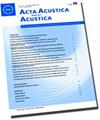Performance of a Low-Height Acoustic Screen for Urban Roads: Field Measurement and Numerical Study
Q1 Arts and Humanities
引用次数: 3
Abstract
Field measurements and numerical modelling were used to study the acoustic performance of a low screen in an urban road setting. The results show the usefulness of low screens as well as suggests improvements in screen design. For the measurements, an acoustic screen built up from concrete modules was temporarily installed beside a small park on the reservation between a two-lane road and a track for walking and cycling. A larger traffic system, of which the two-lane road is a part, determines the daytime equivalent noise level within the urban area. The screen height was about 1.4 m as measured from the level of the road surface and the width of the screen top was 0.3 m. Measurements were carried out both at 20 m distance from the road (within the park) and at 5 m distance from the road (at the cycle track). Insertion loss in maximum level, using controlled lightvehicle pass-by at 50 km/h, was measured to 10 dB at 5 m distance and to 6 dB at 20 m distance, at 1.5 m height. Insertion loss in equivalent level was measured within the park to 4 dB at 1.5 m height. A listening experiment confirmed a perceived improvement from installing the screen. The measured results were also compared with predicted results using a boundary element method (BEM) and a noise mapping software, the latter showing good agreement, overestimating the equivalent level insertion loss by 1 dB in the park. The BEM comparison showed reasonable agreement in maximum level insertion loss considering that facade reflections were excluded, with an overestimation of 5 dB at the cycle track, and good agreement in the park, overestimating by up to 1 dB the equivalent and maximum level insertion losses. BEM predictions were used to also investigate other screen designs, showing a positive effect of an acoustically soft screen top, significant for a screen width of 0.2 m and increasing for wider screens.城市道路低高度声屏的性能:现场测量与数值研究
采用现场测量和数值模拟的方法研究了城市道路设置中低屏的声学性能。研究结果显示了低屏幕的实用性,同时也建议了屏幕设计的改进。为了进行测量,一个由混凝土模块组成的声学屏幕被临时安装在保留区内的一个小公园旁边,该公园位于一条双车道道路和一条步行和骑自行车的轨道之间。一个更大的交通系统,双车道道路是其中的一部分,决定了城市区域内白天的等效噪音水平。筛高约1.4 m(距离路面水平),筛顶宽度0.3 m。测量分别在距离道路20米(公园内)和距离道路5米(自行车道)处进行。在控制轻型车辆以50公里/小时的速度通过时,最大水平的插入损失在5米距离处测量为10 dB,在20米距离处测量为6 dB,高度为1.5 m。在公园内测量等效水平的插入损耗,在1.5 m高度为4 dB。一项听力实验证实了安装屏幕后的明显改善。利用边界元法(BEM)和噪声制图软件对实测结果与预测结果进行了比较,结果表明,边界元法与预测结果吻合较好,将等效电平插入损耗高估了1 dB。BEM对比显示,考虑到排除立面反射,最大水平插入损耗的一致性是合理的,在自行车道上高估了5 dB,在公园中一致性很好,高估了等效和最大水平插入损耗1 dB。BEM预测也用于研究其他屏幕设计,显示了声学软屏幕顶部的积极影响,对于屏幕宽度为0.2 m的屏幕显着,对于更宽的屏幕则增加。
本文章由计算机程序翻译,如有差异,请以英文原文为准。
求助全文
约1分钟内获得全文
求助全文
来源期刊
CiteScore
2.60
自引率
0.00%
发文量
0
审稿时长
6.8 months
期刊介绍:
Cessation. Acta Acustica united with Acustica (Acta Acust united Ac), was published together with the European Acoustics Association (EAA). It was an international, peer-reviewed journal on acoustics. It published original articles on all subjects in the field of acoustics, such as
• General Linear Acoustics, • Nonlinear Acoustics, Macrosonics, • Aeroacoustics, • Atmospheric Sound, • Underwater Sound, • Ultrasonics, • Physical Acoustics, • Structural Acoustics, • Noise Control, • Active Control, • Environmental Noise, • Building Acoustics, • Room Acoustics, • Acoustic Materials and Metamaterials, • Audio Signal Processing and Transducers, • Computational and Numerical Acoustics, • Hearing, Audiology and Psychoacoustics, • Speech,
• Musical Acoustics, • Virtual Acoustics, • Auditory Quality of Systems, • Animal Bioacoustics, • History of Acoustics.

 求助内容:
求助内容: 应助结果提醒方式:
应助结果提醒方式:


